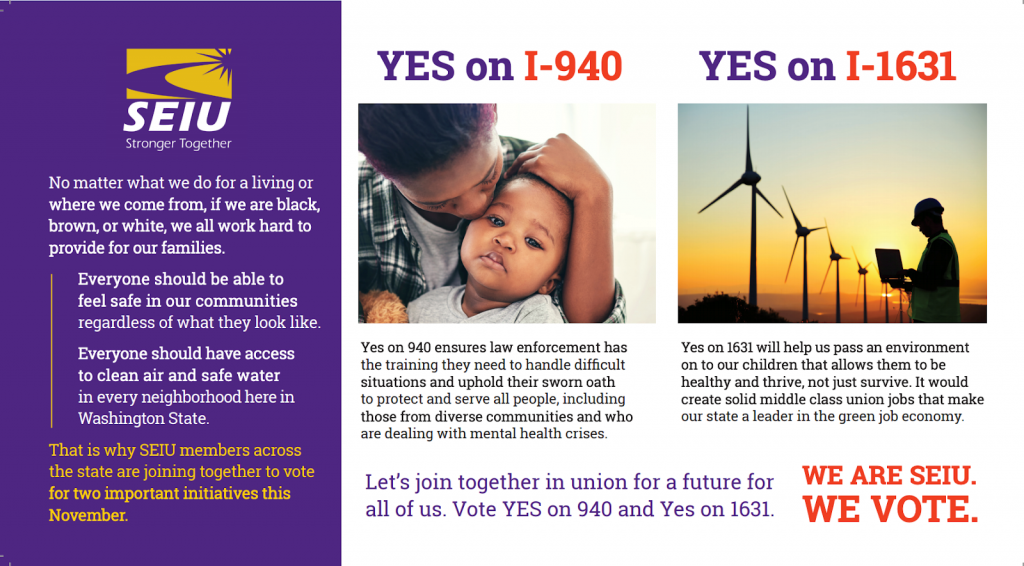How to connect race and class to win against divide-and-conquer narratives

One of the best workshops I went to this year at Netroots Nation was called “The Race Class Narrative: Putting It to Work.” Put together by SEIU and conducted by Josh Keller (SEIU Minnesota State Council), Tinselyn Simms (SEIU), and Christopher Lampkin (SEIU 1199NW), the seminar helped me answer a question I’ve had for a while:
How do we connect race and class?
This is a very timely subject because Donald Trump connects these two narratives in a very powerful and scary way. He tells people that you can only “win” when some other race loses. He demonizes black people, new immigrants, migrants, Muslims, and others and tells white people that the only way they will win is if these other people lose.
I keep hearing a narrative out there that says the solution to this is that we have to moderate in order to win. Here’s an example:

Does anyone think if Joe Biden wins the primary, Republicans are not going to run against Ilhan Omar? We’re seeing the 2020 campaign right now and we know the narrative. It doesn’t matter who we put out there, there will be some racist narrative of us vs. them. See also: Benghazi, the Rev. Jeremiah Wright, birtherism, “white genocide,” and “Obama is a secret Muslim.”
Once we understand that nothing the Democratic Party does is going to change this, the question then is: How do we fight it?
One of the best answers I’ve seen is that we have to have a different and more powerful vision of America. This involves linking race and class narratives to unite people instead of divide them.
The data that tells us this is a winning strategy
Before talking about how to do it, I’m going to talk a little bit about why. It’s important to know that the reason for doing this is not just because it’s the right thing to do, but because it’s also a winning strategy.
The strategy I’m writing about was tested in a nationally representative survey, plus four state-level deeper dives (in California, Indiana, Ohio, and Minnnesota) with subsequent follow-up online ad testing, independent surveys, and canvassing experiments. The original national survey results I’m highlighting below were drawn from a sample of 1,500 adults in spring 2018, plus over-samples of 100 African Americans, 100 Latinos, 100 millennials, 100 drop-off voters, and 100 unlikely voters.
Of this group:
- 23% were considered our base: Strongly concerned about bias against people of color, they support a progressive agenda on racial and economic justice and approve of our narratives.
- 59% were persuadables: They toggle between views shared by our base and by the opposition. For illustration, 72% of persuadables asked say that “focusing on and talking about race is necessary to move forward toward greater equality.” But 65% asked this question also believe “talking about race doesn’t fix anything and may even make things worse.”
- 18% opposition: They think wealth is a product of individual effort, hold African Americans and Latinos responsible for their own conditions, and disapprove of our policy agenda across issues.
To test the theory that combining race and class is both persuasive to the middle and galvanizing to our base, they tested specific sentences against a colorblind approach that was otherwise the same. That is, one formulation was just about class, while the other was about race and class. The only difference was adding in race in a very specific way.
What they found was that adding race improves the efficacy of economic populism, reducing the support for opposition. Hearing these assertions moved people toward wanting to “join together across racial differences.”
Adding race to specific phrases showed a 3% gain in effectiveness with base voters and an 8% gain in effectiveness with persuadables. In addition, when asked about wanting to “join together across racial differences,” the race-class phrasing moved 12% of base voters toward excited (79% saying they were initially excited) and 21% of persuadable voters toward excited (with 55% saying they were already excited).
Part of the reason for this is that people hold two different views about the world: They can have both progressive and regressive views on race, the economy, and government.
Contrary to what many people think, people don’t need to be convinced on many of our issues. They believe many of the things we believe. We just need to participate in the conversation, instead of staying silent and allowing their negative frames to be triggered without opposition.
What does an example look like?
Here’s an example that contains all of the elements of a full race-class narrative.
| WINNING NARRATIVE | DESCRIPTION OF ELEMENTS |
|---|---|
| No matter where we come from or what our color, most of us work hard for our families. | A shared value statement that invokes race and includes everyone. |
| But today, certain politicians and their greedy lobbyists hurt everyone by handing kickbacks to the rich, de-funding our schools, and threatening our seniors with cuts to Medicare and Social Security. Then they turn around and point the finger for our hard times at poor families, black people, and new immigrants. | Names racial scapegoating as a weapon that economically harms all of us. |
| We need to join together with people from all walks of life to fight for our future. | Emphasizes unity and collective action to solve problem. |
| By joining together, we can elect new leaders who work for all of us, not just the wealthy few. | Connects working together to government for all. |
You can do this in conversations
When you’re talking with people, especially persuadables, a race/class narrative like the one above can help garner support, especially if they maybe “kind of” think it’s important but feel other things might be more important.
What links the two together is that the right is using race narratives to divide us against each other. They’re using divisive strategies.
By talking about this openly, it can allow people to see race in a different way, and to see AM radio and Fox News pundits in a different light.
I’ll often ask questions like:
- Why are there so many pundits in the media who scapegoat people?
- Why doesn’t Donald Trump run on his policies, like cutting taxes for the rich and turning the country’s regulatory agencies over to corporate special interests? Why does he hold racist campaign rallies that demonize black people, Latinos, and Muslims?
- Why doesn’t he focus on health care or education, or things that everyone needs?
So many people in our country are struggling right now. We all want access to quality education, to good jobs, to better healthcare. Why aren’t these pundits and politicians trying to solve problems?
When you open conversations up in this way, it gives you the opportunity to then say that we should all come together—white, black, brown—to work on a better life for everyone.
Encourage people and talk about how we did this in the past to win things like the 40-hour work week, weekends, and civil rights.
Here are some tips from the SEIU research for your story:
- Begin with a shared value before moving on to naming the problem:
- The shared value says “I’m a friend”
- Positive framing is retained better by audiences than negative framing
- Call out divide-and-conquer tactics (scapegoating) and connect them to how it economically hurts us all.
- Explicitly name race when articulating an agenda to make life better for working people.
- Name the villain(s) by the tactics they employ, not just who they are:
- If you name villains by what they do (for example, corporate special interests that buy government), you don’t overgeneralize
- Connect the value of working together to achieving an effective government that works for everyone.
- Offer a specific and unifying call to action. Name the payoff from it.

Why this works
Persuadables hold both progressive and reactionary views on race.
If we stay silent and don’t talk about race, then the opposition will talk about it and own the narrative. We see this with race-baiting pundits constantly blathering on AM radio and Fox News. The opposition plays to “fear of the other” narratives instead of linking the solving racism to our shared economic success.
If we talk about racism alone, many may struggle to link solving racism to their own personal situations, especially if they are not minorities.
If we talk about class alone, we risk alienating folks with valid concerns about racism and xenophobia. They may see it as minimizing their struggle. Talking about race and class simultaneously improves the effectiveness of economic populism and reduces support for opposition views.
Basically, we can’t separate the two. They’re linked by the way the wealthy use race to divide people. Instead, use narratives that speak to both race and class as a powerful way to unite people.
——————————–
Summaries of the SEIU research can be downloaded here (C3) and here (C4). The Demos RCN toolkit can be found here. A full report can be downloaded here.
Thank you to the following people behind this wonderful work: Chris Lampkin is the political director of SEIU Healthcare 1199NW, a local union covering 30,000 members in Washington State, Alaska, and Montana. Josh Keller is the communications director for SEIU Minnesota State Council, a united body of Minnesota’s 53,0000 SEIU members who come together to improve the lives of all Minnesotans. Tinselyn Simms is the assistant director of communications at SEIU within the Racial Justice Center, a hub and resource for SEIU’s work to create a world where everyone, no matter the color of their skin, can participate, prosper, and reach their full potential.
SEIU is engaged with the Race-Class Narrative work as a part of a fight for a multiracial democracy that serves the needs of all working people whether white, black, or brown. They are committed to winning $15 an hour and a being a union for all working people. If you have questions or would like to talk more about this research, please reach out to the Racial Justice Center at rjc@seiu.org.










